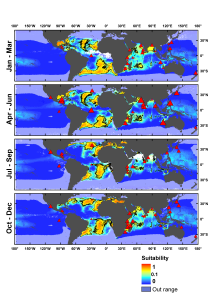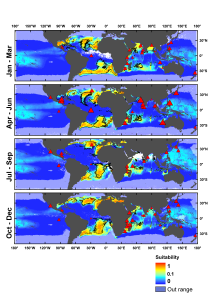
© W. Osborn (AIMS)
My recently finished PhD student, Ana Sequeira, has not only just had a superb paper just accepted in Global Change Biology, she’s recently been offered (and accepted) a postdoctoral position based at the University of Western Australia‘s Oceans Institute (in partnership with AIMS and CSIRO). As any supervisor, I’m certainly pleased when a student completes her PhD, but my pride as an academic papa truly soars when she gets her first job. Well done, Ana. This post by Ana is about her latest paper.
–
Following our previous whale shark work (see here, here, here, here, here, here and here), especially the recent review where we inferred global connectivity and suggest possible pathways for their migration, we have now gone a step further and modelled the habitat suitability for the species at at global scale. This paper sets a nice scene regarding current habitat suitability, which also demonstrates the potential connectivity pathways we hypothesised previously. But the paper goes much further; we extend our predictions to a future scenario for 2070 when water temperatures are expected to increase on average by 2 °C.

Global predictions of current seasonal habitat suitability for whale sharks. Black triangles indicate known aggregation locations. Solid line delineates areas where habitat suitability > 0.1 was predicted.
Regarding the current range of whale sharks (i.e., its currently suitable habitat), we already know that whale sharks span latitudes between about 35 º North to South. We also know that this geographical range has been exceeded on several occasions. What we did not know was whether conditions were suitable enough for whale sharks to cross from the Indian Ocean to the Atlantic Ocean – in other words, whether they could travel between ocean basins south of South Africa. Our global model results demonstrate that suitable habitat in this region does exist at least during the summer, thus supporting our hypotheses regarding global connectivity!
It’s true that the extensive dataset we used (30 years’ worth of whale shark sightings collected by tuna purse seiners in the three major oceans – data provided by the IRD, IOTC and SPC) has many caveats (as do all opportunistically collected data), but we went to great trouble to deal with them in this paper (you can request a copy here or access it directly here). And the overall result: the current global habitat suitability for whale sharks does agree well with current locations of whale shark occurrence, with the exception of the Eastern Pacific for where we did not have enough data to validate.

Predicted shift in global of whale sharks habitat suitability for 2070 under a no-climate-policy reference. Solid line delineates areas where higher habitat suitability (> 0.1) is predicted under current environmental conditions.
As we expected, sea surface temperature was an important predictor of whale shark occurrence, and our projection to 2070 shows a (weak) pole-ward shift in habitat suitability (as expected for many other species). We also forecast a contraction of suitable habitat, with a general loss in the warmer equatorial region of the Atlantic and Indian Oceans. Despite the lack of strong results in the Pacific Ocean, there seems to be a ‘corridor’ of suitable habitat linking the Pacific west and east, which could eventually act as a true corridor linking the populations in these two regions.
With the currently available evidence for global connectivity now corroborated by our global habitat suitability maps, we strongly suggest that the current approach to management of whale shark be revised; there is far too much focus on local populations, with little consideration for the broader (regional) picture. Further, people have thus far completely ignored the potential effects of climate change on this species. We need to act prudently or risk losing the world’s largest fish species.

